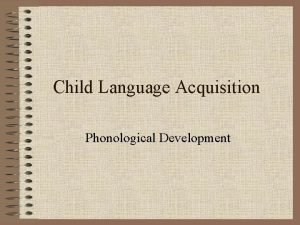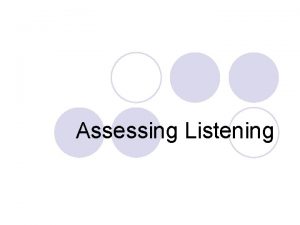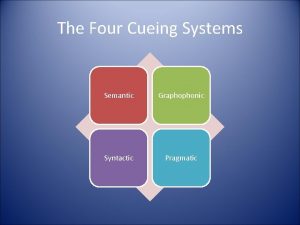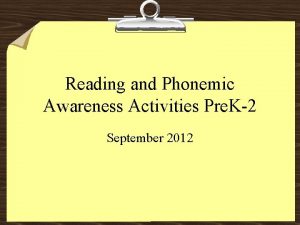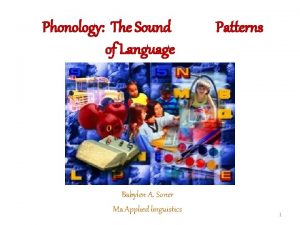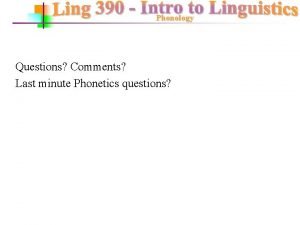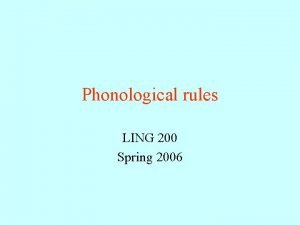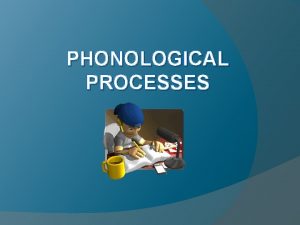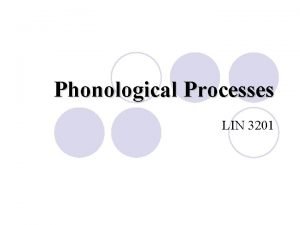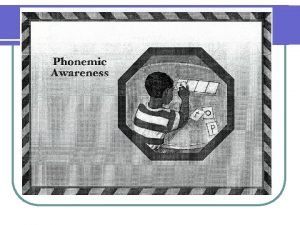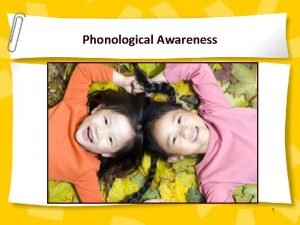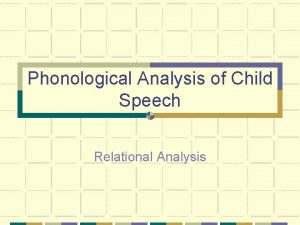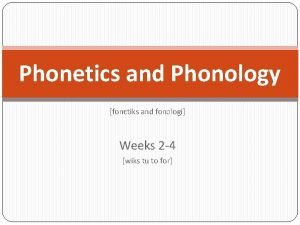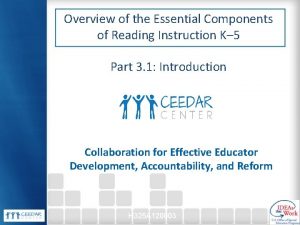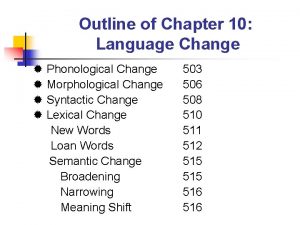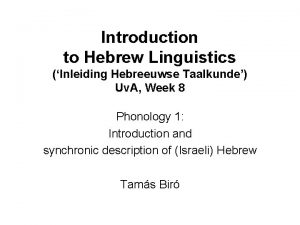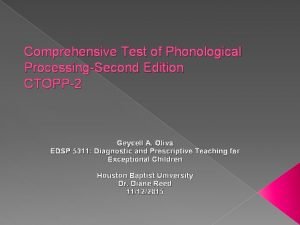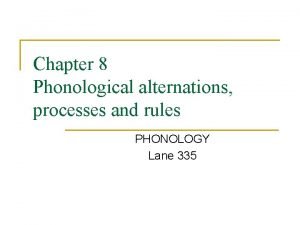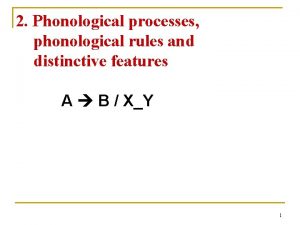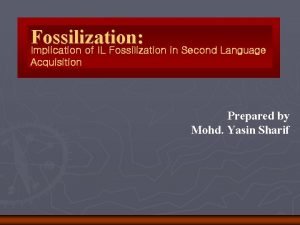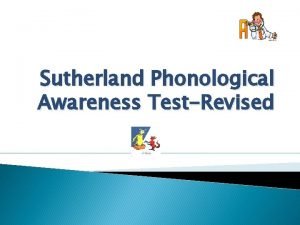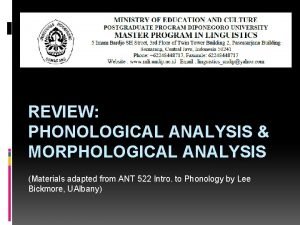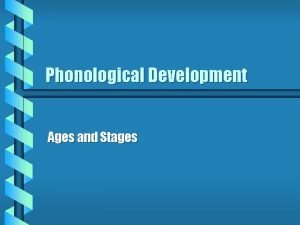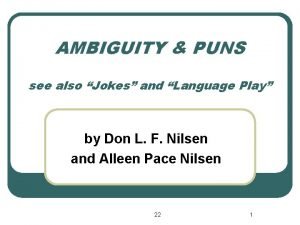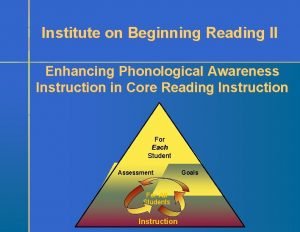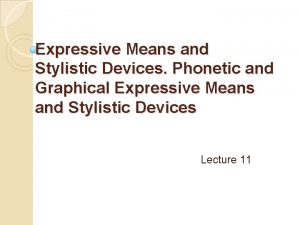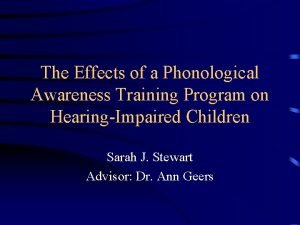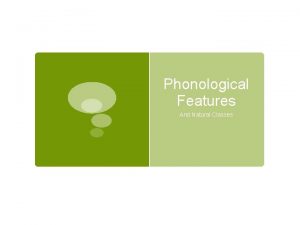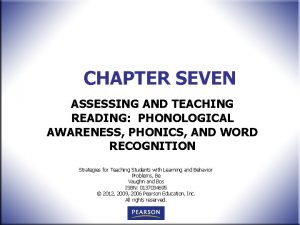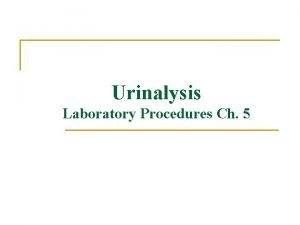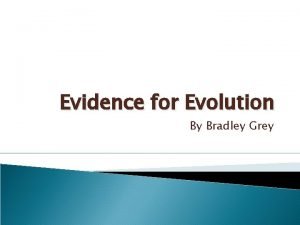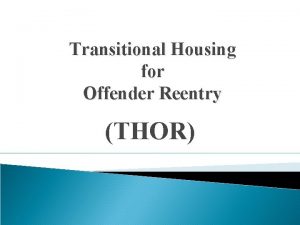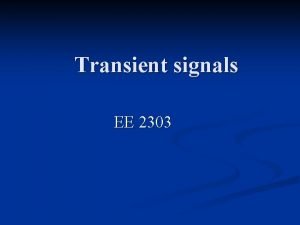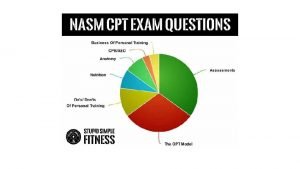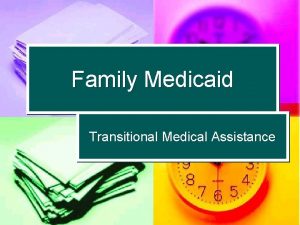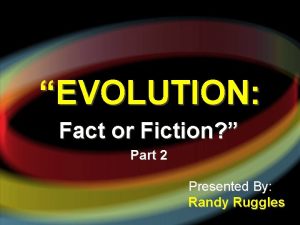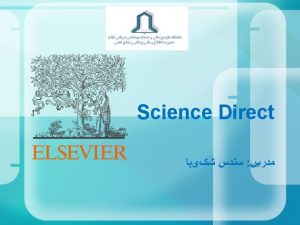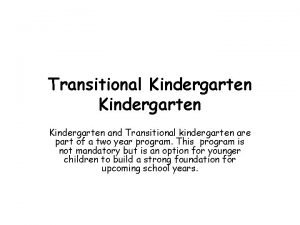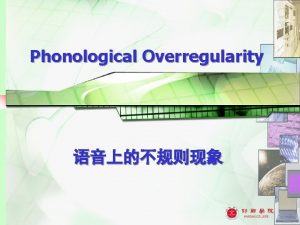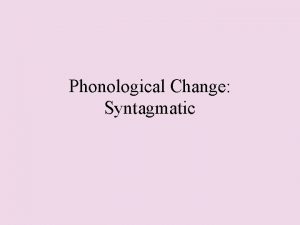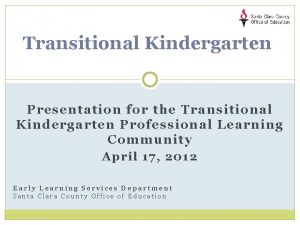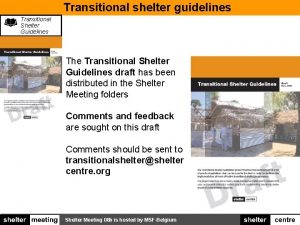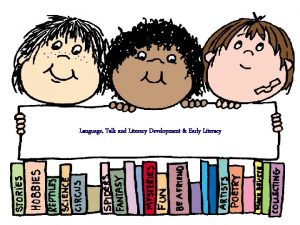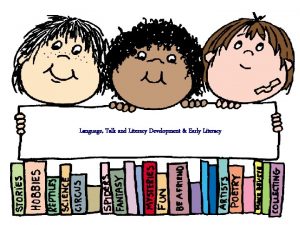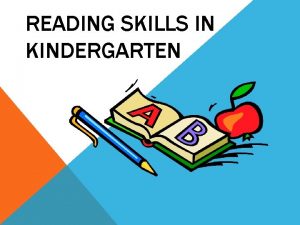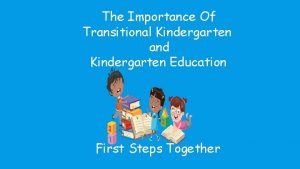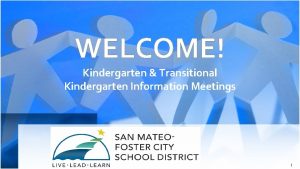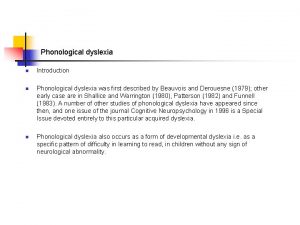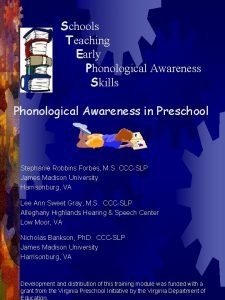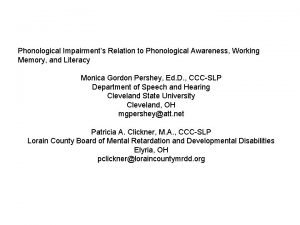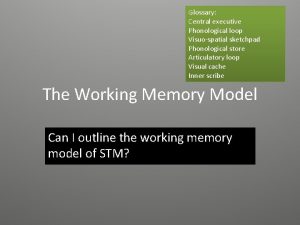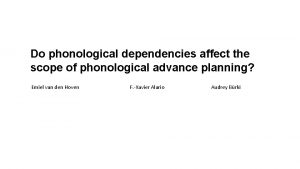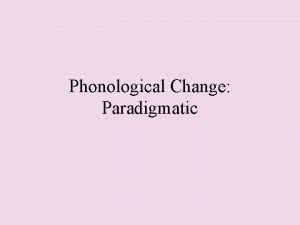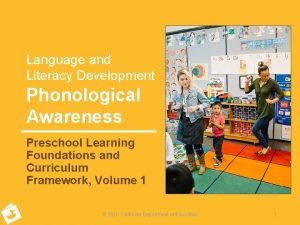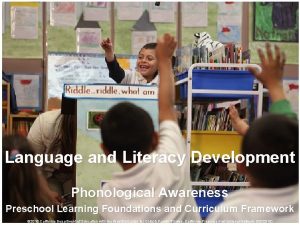1 Language and Literacy in Transitional Kindergarten Phonological


















































- Slides: 50

1 Language and Literacy in Transitional Kindergarten: Phonological Awareness Preschool Learning Foundations and Curriculum Framework © 2017 California Department of Education

2 Objectives: • Gain understanding of key concepts from the California Preschool Learning Foundations, Volume 1 and the California Preschool Curriculum Framework, Volume 1— Language and Literacy domain, Phonological Awareness substrand. • Observe, read, and discuss the developmental continuum for vocabulary that will guide instruction and learning in Transitional Kindergarten (TK). • Practice using the Preschool Learning Foundations and Preschool Curriculum Framework to intentionally plan developmentally appropriate, cultural, and inclusive strategies that promote the development of skills, knowledge, and behaviors related to language and literacy development. © 2017 California Department of Education

Down by the Bay: Using Music to Get in the Mood of Phonological Awareness 1. Stand up and sing “Down by the Bay. ” 2. Listen to the trainer’s “new” lyrics. 3. Each person at the table take a turn making up your own verse. Down by the bay Where the watermelons grow Back to my home I dare not go For if I do My mother will say "Did you ever see a goose kissing a moose? " Down by the bay © 2017 California Department of Education 3

4 Phonological Awareness “‘Phonological awareness’ is generally defined as an individual’s sensitivity to the sound (or phonological) structure of spoken language independent of meaning” (PLF, Vol. 1, p. 79). © 2017 California Department of Education

5 Three Guiding Questions What are the developmental progressions of phonological awareness? What are the developmentally appropriate strategies that support the development of phonological awareness? © 2017 California Department of Education How can I incorporate these strategies into my existing classroom?

6 CDE Publications and Resources that Support TK Implementation Preschool Learning Foundations California Common Core State Standards English-Language Arts Content Standards for California Public Schools Preschool Curriculum Framework English Language Arts/English Language Development Framework DRDP Specific to TK and K Preschool Alignment Document Preschool English Learners Guide Transitional Kindergarten Implementation Guide © 2017 California Department of Education • • • Preschool Learning Foundations California Common Core State Standards English–Language Arts Content Standards for California Public Schools Preschool Curriculum Frameworks English Language Arts/English Language Development Framework DRDP Specific to TK and K Preschool Alignment Document Preschool English Learners Guide Transitional Kindergarten Implementation Guide

7 Transitional Kindergarten Implementation Guide The TK Implementation Guide is a resource for California public school district administrators and teachers to support implementation of comprehensive TK programs. © 2017 California Department of Education

Overview of the Transitional Kindergarten Implementation Guide Section One • Program Structure and Design Section Two • The TK Student • Curriculum in a TK Program • Effective Instruction in a TK Program • The TK Learning Environment • Assessment and Differentiated Instruction • Involving Families and Community Partners • Supporting TK Implementation © 2017 California Department of Education 8

Why Use the Preschool Learning Foundations for TK? CA Law (EC 48000): • Transitional kindergarten is the first year of a two -year kindergarten program that uses a modified kindergarten curriculum that is age and developmentally appropriate. • Transitional kindergarten programs are intended, by legislative action, to be aligned to the California Preschool Learning Foundations developed by the California Department of Education. © 2017 California Department of Education

10 Foundations and Framework, Volume 1 © 2017 California Department of Education

11 Map of the Foundations: Language and Literacy Strand Domain Substrand Age Foundation Substrand Description Examples Includes notes for children with disabilities © 2017 California Department of Education

12 Crossword Time Use the glossary (page 89) and the introduction (pages 52 -53) sections of the Preschool Learning Foundations (Volume 1) to complete Handout 2 A: Crossword Puzzle with your table partner. © 2017 California Department of Education

13 Alignment Document © 2017 California Department of Education

14 Alignment Document: Language and Literacy © 2017 California Department of Education

The Importance of Phonological Awareness Phonological awareness plays a critical role in the acquisition of several critical reading skills including: • Understanding the alphabetic principle • Decoding printed words • Spelling © 2017 California Department of Education 15

16 Phonological Units • Words • Syllables • Onset and Rime o Onset - The first consonant or consonant cluster in a syllable (e. g. , the h in the one syllable word hat, the m and k in the two syllables in the word monkey) o Rime - Everything left in a syllable after the onset is removed; the vowel and coda of a syllable (e. g. , the at in the single syllable word hat, the in in the single-syllable word in) • Phonemes (individual sounds) © 2017 California Department of Education

17 Developmental Continuum • • • Detect and Manipulate words and syllables within words Awareness of onset and rime Awareness of phonemes © 2017 California Department of Education

18 Language and Literacy Reading Strand: Phonological Awareness 60 month foundation 2. 1 Orally blend and delete words and syllables without the support of pictures or objects: • Orally blend words • Orally blend syllables • Orally take apart words • Orally take apart syllables © 2017 California Department of Education

19 Language and Literacy Reading Strand: Phonological Awareness 60 month foundation 2. 2 Orally blend the onsets, rimes, and phonemes of words and orally delete the onsets of words, with the support of pictures or objects: • Blend onsets and rimes • Delete onsets • Blend individual phonemes © 2017 California Department of Education

20 Understanding Phonological Units Using the language and literacy foundations on phonological awareness, complete the matching activity with your tablemates. © 2017 California Department of Education

21 Focused Video Viewing: LL- Reading Phonological Awareness © 2017 California Department of Education

22 Video Reflection • What did you notice that you have also seen in your classroom? • What did you notice about the developmental progression? Share your thoughts with your tablemates. © 2017 California Department of Education

Phonological Awareness and Languages “Research supports that phonological awareness skills are related across languages for bilinguals” (Anthony et al. 2009; Dickinson et al. 2004; Kim 2009; Lo pez and Greenfield 2004; Tabors, Pa ez, and Lo pez 2003) as cited in the Dual Language Learners Overview Papers, p. 67). © 2017 California Department of Education 23

English-Language Development Foundations 6. 0 Children demonstrate phonological awareness. Focus: Rhyming Beginning Middle Later 6. 1 Listen attentively and begin to participate in simple songs, poems, and finger plays that emphasize rhyme in the home language or in English. 6. 1 Begin to repeat or recite simple songs, poems, and finger plays that emphasize rhyme in the home language or in English. 6. 1 Repeat, recite, produce, or initiate simple songs, poems, and finger plays that emphasize rhyme in English. (PLF, Vol. 1, p. 131) © 2017 California Department of Education 24

English-Language Development Foundations 6. 0 Children Demonstrate Phonological Awareness. Focus: Onset (Initial Sound) Beginning Middle Later 6. 2 Listen attentively and begin to participate in simple songs, poems, and finger plays in the home language or English. 6. 2 Begin to recognize words that have a similar onset (initial sound) in the home language or in English. 6. 2 Recognize and produce words that have a similar onset (initial sound) in English. (PLF, Vol. 1, p. 132) © 2017 California Department of Education 25

English-Language Development Domain 6. 0 Children Demonstrate Phonological Awareness. Focus: Sound Differences in the Home Language and English PLF, Vol. 1, p. 133 © 2017 California Department of Education 26

Focused Video Viewing: Watch for the Developmental Change between Beginning, Middle, and Later © 2017 California Department of Education 27

28 Video Reflection • What are the differences between the developmental levels (beginning, middle, later)? • How does the teacher adapt her lesson (sound differences) to support children’s phonological awareness? • Have you had a similar experience in your classroom? © 2017 California Department of Education

29 Key Features of the DRDP-K (2015) • An observation-based assessment tool, not a test • Individual child assessment • Completed by each child’s teacher • Based on developmental research and theory • Includes developmental sequences of behaviors along a continuum • Spans the developmental continuum of children in a two-year kindergarten program © 2017 California Department of Education

30 DRDP-K (2015) Language and Literacy Phonological Awareness © 2017 California Department of Education

31 Three Guiding Questions What are the developmental progressions of phonological awareness? What are the developmentally appropriate strategies that support the development of phonological awareness? © 2017 California Department of Education How can I incorporate these strategies into my existing classroom?

32 Key Resources © 2017 California Department of Education

33 Curriculum Framework: Strategies to Enrich Learning Opportunities • Interaction and strategies • Routines, environments, and materials • Planned learning opportunities • Partnering with Families © 2017 California Department of Education

Universal Design for Learning Multiple means of: • Expression • Representation • Engagement 34 © 2017 California Department of Education 35

35 Scaffolding © 2017 California Department of Education

36 Play Games © 2017 California Department of Education

37 Time to Play Language Games © 2017 California Department of Education

Embedding Phonological Awareness Throughout the Day Arrival and Departure • Students line up when teacher says the sound with which their names start. • Invite students to pair up and exit the classroom with a friend whose name begins with the same sound as their name. Snack Time • Play “I Spy: ” Have students look for objects that begin with a certain sound or that rhyme with a certain word. Transitions • Put small objects in a brown bag. As children are waiting for others, pull out an object and have children think of a word that starts with the same sound. • Have children clap the number of syllables in their names as they go from circle to centers. © 2017 California Department of Education 38

39 Encouraging and Engaging Phonological Awareness Throughout Daily Routine • Locate Handout 11. • Revisit pages 137 -139 in the Preschool Curriculum Framework. • Fill out your daily routine with ideas from the pages you read, the games you played and discussion with your table group. © 2017 California Department of Education

English Language Arts/ English Language Development Framework ELA/ELD Framework 2014, Chapter 3, p. 155) © 2017 California Department of Education 40

41 Planning for Phonological Awareness Across the Curriculum • Read Snapshot 3. 1, p. 184 -185 of the ELA/ELD Framework. • Discuss: – What did you find interesting about the reading? – How might you replicate what you read? – What might you do to extend this experience even more? © 2017 California Department of Education

42 “Children learn everywhere” (PCF, Vol. 1, p. 100). Community Teachers Families Child © 2017 California Department of Education

43 Families “Connect school and home” (PCF, . Vol. 1, p. 101). © 2017 California Department of Education

44 Partner with Families • Engaging Families: Preschool Curriculum Framework • All About Young Children • Best Practices for Planning Curriculum: Family Partnerships and Culture • TK Implementation Guide

45 Home-School Connections Reflect and Discuss: • What are some ways to engage families with phonological awareness activities at home and school? • How can you include experiences from the home lives of students in phonological awareness experiences at school? © 2017 California Department of Education

46 Three Guiding Questions What are the developmental progressions of phonological awareness? What are the developmentally appropriate strategies that support the development of phonological awareness? © 2017 California Department of Education How can I incorporate these strategies into my existing classroom?

47 Teacher Strategies “Phonological awareness does not develop naturally over time, but as a consequence of children’s engagement in specific experiences” (PCF, Vol. 1, p. 133). © 2017 California Department of Education

48 Final Reflections • Find Handout 12: Final Reflection. • Find someone you have not talked with today and share your thoughts. © 2017 California Department of Education )

49 Thank You for Coming! © 2017 California Department of Education

50 References Bredekamp, Sue, and Carol Copple. Developmentally Appropriate Practice in Early Childhood Programs. NAEYC, 2008. California Department of Education. 2013. Best Practices for Young Dual Language Learners Research: Overview Papers, Governor’s State Advisory Council on Early Learning and Care. http: //www. cde. ca. gov/sp/cd/ce/documents/dllresearchpapers. pdf (accessed May 11, 2016). California Department of Education. 2010. California Preschool Curriculum Framework, Volume 1. http: //www. cde. ca. gov/sp/cd/re/documents/psframeworkkvol 1. pdf (accessed April 10, 2016). California Department of Education. 2011. California Preschool Curriculum Framework, Volume 2. http: //www. cde. ca. gov/sp/cd/re/documents/psframeworkkvol 2. pdf (accessed May 10, 2016). California Department of Education. 2013. California Preschool Curriculum Framework, Volume 3. http: //www. cde. ca. gov/sp/cd/re/documents/psframeworkkvol 3. pdf (accessed May 10, 2016). California Department of Education. 2008. California Preschool Learning Foundations, Volume 1. http: //www. cde. ca. gov/sp/cd/re/documents/preschoollf. pdf (accessed April 10, 2016). California Department of Education. 2012. The Alignment of the California Preschool Learning Foundations with Key Early Education Resources. http: //www. cde. ca. gov/sp/cd/re/documents/psalignment. pdf (accessed May 10, 2016). California Department of Education. 2013. Transitional Kindergarten Implementation Guide: A Resource for California Public School District Administrators and Teachers. Sacramento: California Department of Education. State Advisory Council on Early Learning and Care. California Department of Education. California's Best Practices for Young Dual Language Learners: Research Papers. 2013. Accessed May 12, 2016. http: //www. cde. ca. gov/sp/cd/ce/documents/dllresearchpapers. pdf. © 2017 California Department of Education
 Phonological development in child language acquisition
Phonological development in child language acquisition Media literacy vs information literacy comparison
Media literacy vs information literacy comparison Media and information literacy ppt
Media and information literacy ppt Differences of people in media and people as media
Differences of people in media and people as media Cyber literacy for the digital age
Cyber literacy for the digital age Communicative stimulus-response tasks
Communicative stimulus-response tasks Phonological ambiguity
Phonological ambiguity What is syntactic cues
What is syntactic cues Phonological loop
Phonological loop Why is phonological awareness important
Why is phonological awareness important Phonological loop
Phonological loop Onset coda and nucleus
Onset coda and nucleus What are minimal pairs in linguistics
What are minimal pairs in linguistics Phonological rule
Phonological rule Coalescence phonological process
Coalescence phonological process Assimilation rules in phonology
Assimilation rules in phonology Phonological continuum
Phonological continuum Phonemic awareness continuum
Phonemic awareness continuum Independent analysis speech
Independent analysis speech Whats an allophone
Whats an allophone Phonological continuum
Phonological continuum Semantic change
Semantic change Proto semitic
Proto semitic Ctopp composite scores
Ctopp composite scores Alpha notation linguistics
Alpha notation linguistics Dentalized d
Dentalized d Fossilization in language
Fossilization in language Sutherland phonological awareness test
Sutherland phonological awareness test Phonological analysis example
Phonological analysis example Phonological development stages
Phonological development stages Teeter sperber
Teeter sperber Blending examples
Blending examples Expressive means
Expressive means Phonological awareness training program
Phonological awareness training program Emma elkonin
Emma elkonin Phonological features chart
Phonological features chart What is letter sound relationship
What is letter sound relationship Renal tubular cell
Renal tubular cell Transitions for topic sentences
Transitions for topic sentences Transitional words
Transitional words Transitional fossils
Transitional fossils Transitional epithelium
Transitional epithelium Thor approved programs
Thor approved programs Transient signal oscilloscope
Transient signal oscilloscope Dynamic postural assessment pulling
Dynamic postural assessment pulling Dynamic postural assessment: overhead
Dynamic postural assessment: overhead Stratified columnar
Stratified columnar What are the 5 principles of hair design
What are the 5 principles of hair design Transitional epithelium
Transitional epithelium Transitional medical assistance ohio
Transitional medical assistance ohio Evolution fact or fiction
Evolution fact or fiction
